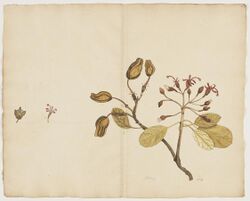Biology:Ungeria
| Ungeria | |
|---|---|

| |
| Watercolour illustration by John Doody of Ungeria floribunda | |
| Scientific classification | |
| Kingdom: | Plantae |
| Clade: | Tracheophytes |
| Clade: | Angiosperms |
| Clade: | Eudicots |
| Clade: | Rosids |
| Order: | Malvales |
| Family: | Malvaceae |
| Subfamily: | Helicteroideae |
| Genus: | Ungeria Schott & Endl. |
| Species: | U. floribunda
|
| Binomial name | |
| Ungeria floribunda Schott & Endl.
| |
Ungeria is a monotypic genus of flowering plants belonging to the family Malvaceae. It just contains one species, Ungeria floribunda Schott & Endl.[1] It is also in the Helicteroideae subfamily and Helictereae tribe.[2]
Its native range is Norfolk Island (in the Pacific Ocean near Australia).[1] It is found in Mount Pitt Nature Reserve (part of Norfolk Island National Park).[3]
Description
It is a tree that can grow up to 15 m (49 ft) tall.[4] It has leaves which are broadly elliptic or obovate and evergreen.[5] The leaf blades are about 6–12 cm (2–5 in) long and 4–8 cm (2–3 in) wide.[3] It has deep pink flowers.[5] The flowers each have five deep pink petals 16–20 mm (1–1 in) long and it thought to be pollinated by birds. The fruits are 5 lobed and star-shaped in cross-section.[3]
Moths of Austrocarea iocephala subspecies millsi can be found on the tree.[6]
It is related (dna wise) to the Durian.[3]
Taxonomy
It has the common name of 'Bastard Oak', (due to the inferior quality of the timber,[3]) was listed as Vulnerable in 2003 on Norfolk Island.[7] 502 plants were counted in 2003.[3]
The genus name of Ungeria is in honour of Franz Unger (1800–1870), an Austrian botanist, paleontologist and plant physiologist.[8] The Latin specific epithet of floribunda means "many-flowering", (such as Floribunda).[9] Both the genus and sole species were first described and published in Meletemata Botanica (Melet. Bot.) on page 27 in 1832.[1] The genus is recognized by the United States Department of Agriculture and the Agricultural Research Service, but they do not list any known species.[2]
Culture
On 14 January 2020, an image of Ungeria floribunda was used on a postage stamp for Australia, one of two 'Norfolk Island Early Botanical Art' stamps.[4]
References
- ↑ 1.0 1.1 1.2 "Ungeria Schott & Endl. | Plants of the World Online | Kew Science" (in en). https://powo.science.kew.org/taxon/urn:lsid:ipni.org:names:38847-1.
- ↑ 2.0 2.1 "Genus Ungeria Schott & Endl.". https://npgsweb.ars-grin.gov/gringlobal/taxon/taxonomygenus?id=12557.
- ↑ 3.0 3.1 3.2 3.3 3.4 3.5 Peter Coyne Norfolk Island's Fascinating Flora (2011), p. 84, at Google Books
- ↑ 4.0 4.1 "stamp Ungeria floribunda 2020" (in en). https://www.anbg.gov.au/stamps/stamp-ungeria-floribunda-2020.html.
- ↑ 5.0 5.1 Australian Government Pub. Service, 1982 Flora of Australia, Volume 49, p. 108, at Google Books
- ↑ J.D. Holloway Lepidoptera of Norfolk Island. Their Biogeography and Ecology (1977), p. 77, at Google Books
- ↑ "Ungeria floribunda — Bastard Oak". https://www.environment.gov.au/cgi-bin/sprat/public/publicspecies.pl?taxon_id=41714.
- ↑ Burkhardt, Lotte (2018) (in German) (pdf). Verzeichnis eponymischer Pflanzennamen – Erweiterte Edition. Berlin: Botanic Garden and Botanical Museum, Freie Universität Berlin. doi:10.3372/epolist2018. ISBN 978-3-946292-26-5. https://doi.org/10.3372/epolist2018. Retrieved 1 January 2021.
- ↑ Harrison, Lorraine (2012). RHS Latin for Gardeners. United Kingdom: Mitchell Beazley. ISBN 184533731X.
Wikidata ☰ {{{from}}} entry
 |

